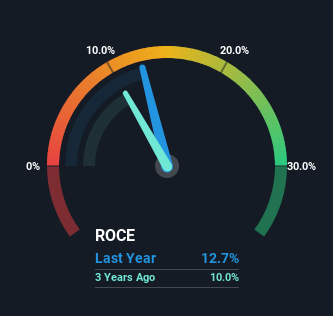- Hong Kong
- /
- Consumer Services
- /
- SEHK:2001
China New Higher Education Group (HKG:2001) Is Doing The Right Things To Multiply Its Share Price
There are a few key trends to look for if we want to identify the next multi-bagger. Ideally, a business will show two trends; firstly a growing return on capital employed (ROCE) and secondly, an increasing amount of capital employed. This shows us that it's a compounding machine, able to continually reinvest its earnings back into the business and generate higher returns. Speaking of which, we noticed some great changes in China New Higher Education Group's (HKG:2001) returns on capital, so let's have a look.
What Is Return On Capital Employed (ROCE)?
Just to clarify if you're unsure, ROCE is a metric for evaluating how much pre-tax income (in percentage terms) a company earns on the capital invested in its business. The formula for this calculation on China New Higher Education Group is:
Return on Capital Employed = Earnings Before Interest and Tax (EBIT) ÷ (Total Assets - Current Liabilities)
0.13 = CN¥730m ÷ (CN¥9.2b - CN¥3.5b) (Based on the trailing twelve months to February 2024).
So, China New Higher Education Group has an ROCE of 13%. That's a relatively normal return on capital, and it's around the 12% generated by the Consumer Services industry.
Check out our latest analysis for China New Higher Education Group

In the above chart we have measured China New Higher Education Group's prior ROCE against its prior performance, but the future is arguably more important. If you'd like, you can check out the forecasts from the analysts covering China New Higher Education Group for free.
What Does the ROCE Trend For China New Higher Education Group Tell Us?
Investors would be pleased with what's happening at China New Higher Education Group. The data shows that returns on capital have increased substantially over the last five years to 13%. The amount of capital employed has increased too, by 62%. This can indicate that there's plenty of opportunities to invest capital internally and at ever higher rates, a combination that's common among multi-baggers.
The Bottom Line
All in all, it's terrific to see that China New Higher Education Group is reaping the rewards from prior investments and is growing its capital base. Astute investors may have an opportunity here because the stock has declined 13% in the last five years. That being the case, research into the company's current valuation metrics and future prospects seems fitting.
On a final note, we've found 2 warning signs for China New Higher Education Group that we think you should be aware of.
While China New Higher Education Group isn't earning the highest return, check out this free list of companies that are earning high returns on equity with solid balance sheets.
New: AI Stock Screener & Alerts
Our new AI Stock Screener scans the market every day to uncover opportunities.
• Dividend Powerhouses (3%+ Yield)
• Undervalued Small Caps with Insider Buying
• High growth Tech and AI Companies
Or build your own from over 50 metrics.
Have feedback on this article? Concerned about the content? Get in touch with us directly. Alternatively, email editorial-team (at) simplywallst.com.
This article by Simply Wall St is general in nature. We provide commentary based on historical data and analyst forecasts only using an unbiased methodology and our articles are not intended to be financial advice. It does not constitute a recommendation to buy or sell any stock, and does not take account of your objectives, or your financial situation. We aim to bring you long-term focused analysis driven by fundamental data. Note that our analysis may not factor in the latest price-sensitive company announcements or qualitative material. Simply Wall St has no position in any stocks mentioned.
Have feedback on this article? Concerned about the content? Get in touch with us directly. Alternatively, email editorial-team@simplywallst.com
About SEHK:2001
China New Higher Education Group
An investment holding company, provides private education services in the People's Republic of China.
Undervalued with proven track record.
Market Insights
Community Narratives


Recently Updated Narratives


Engineered for Stability. Positioned for Growth.


MINISO's fair value is projected at 26.69 with an anticipated PE ratio shift of 20x


Fiverr International will transform the freelance industry with AI-powered growth
Popular Narratives


MicroVision will explode future revenue by 380.37% with a vision towards success


NVDA: Expanding AI Demand Will Drive Major Data Center Investments Through 2026



